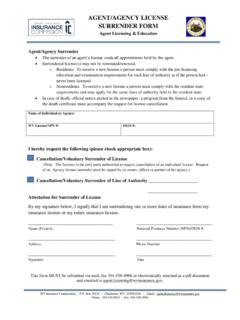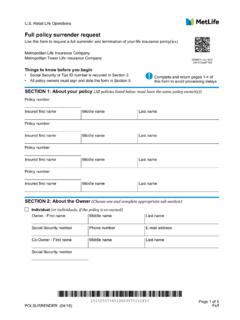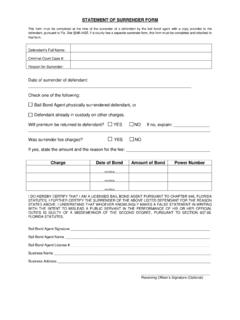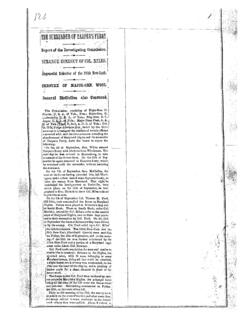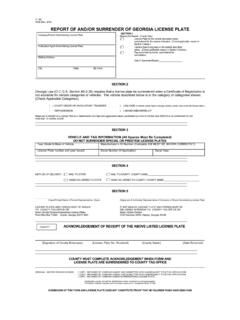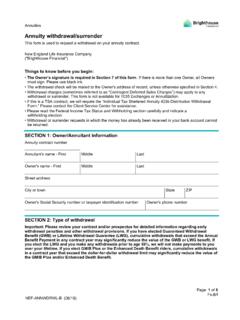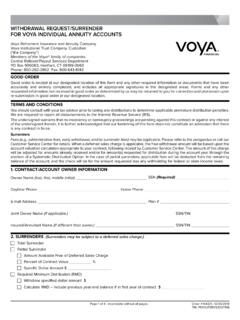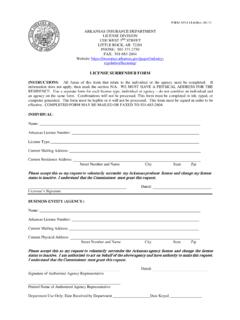Transcription of An Empirical Analysis of Life Insurance Policy Surrender ...
1 35 Journal of Insurance Issues, 2013, 36 (1): 35 2013 by the Western Risk and Insurance rights Empirical Analysis of life Insurance Policy Surrender Activity David T. Russell,1 Stephen G. Fier,2 James M. Carson,3 and Randy E. Dumm4 Abstract: We analyze life Insurance Policy Surrender activity to determine whethersurrender is a function of certain macroeconomic variables and, therefore, highlycorrelated across policies. Results support the Emergency Fund Hypothesis and theInterest Rate Hypothesis. In addition, we provide evidence that surrenders are signif icantly related to Policy replacement activity, as in Outreville (1990), which we referto as the Policy Replacement Hypothesis. The significant relationship between policysurrender and macroeconomic factors strongly supports insurer efforts to understandand actively manage disintermediation risk via Insurance contract features and invest ment Policy . [Key words: life Insurance , Surrender , disintermediation, insolvency,regulation.]
2 ] JEL Classification: E20, G11, option to Surrender a life Insurance Policy exposes insurers tomacroeconomic activity that may result in disintermediation andpossible financial distress. Rapidly rising interest rate levels and volatility1 Associate Professor of Insurance and Finance, Department of Finance, Real Estate, andInsurance, California State University, Northridge, Northridge, CA. King Professor of Insurance , Department of Finance, School of Business Adminis tration, The University of Mississippi, University, MS 38677. P. Amos Distinguished Professor of Insurance , Department of Insurance , LegalStudies, and Real Estate, Terry College of Business, The University of Georgia, Athens, GA30602 6255. Professor and Peoples First Insurance Fellow, Department of Risk Management/ Insurance , Real Estate, and Legal Studies, College of Business, The Florida State University,Tallahassee, FL 32306. authors acknowledge helpful comments from the Editor, two anonymous reviewers,and David Eckles, as well as participants at meetings of ARIA, WRIA, SRIA, and the Ger man Insurance Science ET the late 1970s and early 1980s led life insurers to reexamine theirexposure to interest rate fluctuations and to focus on asset/liability man agement, including the exposure arising from option like features embed ded in most life Insurance Policy Significant economic shockssuch as the Great Recession of 2008 2009 serve to accentuate the systemicrisks associated with financial ( , bank and insurer) assets and liabilitiesthat are highly correlated with macroeconomic Given the potential for significant cash outflows for life insurers, it isimportant to assess the degree to which economic factors such as adverseeconomic conditions and changing interest rates relate to Policy surrenderactivity.
3 We empirically examine the life Insurance Policy Surrender deci sion, focusing on the macroeconomic factors that are expected to relate topolicy Surrender activity for the period 1995 through 2009. As a previewto our findings, the results indicate that Surrender activity is significantlyrelated to interest rates, unemployment, and income. We also find thatsurrender activity is significantly related to Policy replacement. Thesefindings suggest a correlation among insurer cash flows that, underadverse economic conditions, could ultimately result in insurer financialdistress and that therefore should be actively managed by life insurers. This paper is organized as follows: We first discuss the nature of theproblem facing life insurers posed by embedded options in life insurancepolicies. We then review previous research on the topics of life insurancedisintermediation, including Policy surrenders and loans. We then presentand discuss the Empirical results, and we conclude with a summary andpossible avenues for future Surrender OPTION IN CASH VALUE life INSURANCES mith (1982) and Walden (1985) argue that permanent life insurancemay be viewed as a package of options, including the Policy surrenderoption and the Policy loan option, among The Surrender option,5 Examples would include guaranteed insurability options, term conversions to whole lifeinsurance, Policy Surrender options, guaranteed interest rates, and guaranteed loan rates.
4 6As long ago as 1932, Linton suggested that life Insurance surrenders and Policy loans werefunctions of economic duress. A sharp increase in policyholder surrenders and loans duringthe Great Depression supported Linton s 61 percent of life Insurance policies purchased in 2010 were permanent lifeinsurance policies (ACLI, 2011). Permanent life Insurance policies include whole life , univer sal life , variable life , and endowment type OF life Insurance Policy Surrender ACTIVITY 37sometimes referred to as the lapse option, allows the policyholder toterminate coverage and to receive the cash Surrender value, if Surren der charges are levied to recover the company s initial costs of issuing thepolicy and to encourage policyholder While several otheroptions are embedded in the cash value life Insurance Policy , the surrenderoption involves the potential payout of large sums by the insurer and acomplete termination of coverage. Thus, the Surrender option represents apotential cash flow problem for the insurer, as Policy surrenders couldresult in a significant drain on insurer assets and income.
5 Until the mid 1970s, life Insurance Policy surrenders were fairlysteady, with increases that appear to occur around times of possible eco nomic hardship or inflation, and decreases during periods of prosperityand price stability. The advent of relatively high interest rates and increasedvolatility in the late 1970s and early 1980s, coupled with the introductionof new life Insurance products (such as universal life ), led many Policy holders to Surrender their policies for various reasons including interestrate arbitrage, economic hardship, and Policy replacement with new lifeinsurance contracts and/or other financial products. Clancy (1985) notesthat the unprecedented disintermediation that followed these surrenderscost the life Insurance industry hundreds of millions of dollars. Insurerswere forced to liquidate bonds to meet Surrender requests at precisely thetime when the values of bond portfolios were depressed by high Surrender option allows the policyholder to put the Policy backto the insurer for a specified value determined by the contract typically there is a penalty ( , Surrender charge) for exercising thisoption in the early years after a life Insurance contract is issued, a wholelife Insurance contract can be thought of as a putable bond with a variableyield and an increasing strike price.
6 However, unlike a floating rate note,the insurer is not bound by the contract to pay an interest rate based on aspecific index or The stickiness of insurer crediting rates,coupled with the Surrender option, is what gives the policyholder the8 Stalson (1969) and Cummins (1973b) credit development of the modern day surrenderoption to Elizur Wright, the first Insurance Commissioner of whole life contracts, the Surrender charge is effectively embedded in the expenses andtypically equates to most or all of the first year s premium. For universal life contracts, thesurrender charge typically is a declining function of the Policy s value life Insurance may be thought of as debt. Because cash value life Insurance isissued with a Surrender option, the Policy can be considered a putable bond issued by theinsurer ( , Bacinello, 2003).11 For participating whole life policies, the insurer s board declares an interest rate that isbased on company performance as well as competitive concerns.
7 38 RUSSELL ET for interest rate arbitrage and creates interest rate risk for theinsurer. Just as homeowners may refinance a mortgage, policyholders ofsome life Insurance products have an incentive (actual or perceived) tosurrender an older Policy in favor of one that pays a higher Theexpected connection between life Insurance disintermediation andincreases in interest rates has come to be known simply as the Interest RateHypothesis. Regulation also plays an integral role in the insurer s offerings, whichultimately impact the insurer s overall risk. In the case of cash value lifeinsurance, state regulation requires life insurers to offer policyholders theright to redeem their policies for a contractually guaranteed minimumvalue regardless of economic conditions. However, economic conditionscould compel many policyholders to exercise the Surrender option withina short period of time. While these demands for Policy Surrender proceeds(and/or Policy loans) are not loss claims, they do represent cash outflowsthat could be correlated with certain macroeconomic factors that may notbe effectively managed under the insurer s asset liability managementplan.
8 These potentially correlated cash flows represent a liquidity risk forinsurers, particularly because insurers invest a substantial portion of theirassets in somewhat illiquid assets such as mortgages, real estate, andprivate placement securities. Insurer liquidity and solvency are particularly threatened if life insur ance surrenders are directly correlated with interest rates. Since an increasein interest rates would result in a decline in the value of fixed income assets,an increase in surrenders that accompanied an increase in interest rateswould force the insurer to liquidate assets at a time when it was mostinopportune to do addition to changes in interest rates, other macroeconomic eventsthat result in financial hardship, such as unemployment, may also increasesurrender activity and represent a potential correlated cash flow risk to thelife insurer. Under Linton s Emergency Fund Hypothesis (1932), surrenderactivity should increase during periods of economic duress. Hence, insur ers need to be prepared for a systematic increase in surrenders 12If the returns on life Insurance cash values were adjusted instantaneously to reflect currentmarket yields, then Surrender activity might be insensitive to changes in interest rates.
9 How ever, most insurer portfolios are invested in assets that have long durations and, as a result,dividends and crediting rates on cash values often reflect some degree of stickiness ofincome on insurer portfolios. In other words, this income stream is slow to adjust to changesin market rates. Without the Surrender option, the life Insurance Policy would decline invalue as interest rates rise, just as any fixed income instrument OF life Insurance Policy Surrender ACTIVITY 39 life insurers may have an exposure due to a correlation betweensurrender activity and sales. In the absence of unusual Insurance marketconditions, increases in Surrender activity likely would be accompanied bydecreases in life Insurance sales, thereby exacerbating decreases in insurerliquidity and While life insurers typically are well prepared forpolicy surrenders, a flood of requests could threaten a company s (or theindustry s) liquidity and, as a result, its solvency. Insurer asset liquidationsalso could drive asset prices lower, causing a snowball effect similar tothe high yield bond liquidations forced on savings and loans in the , other factors such as insurer credit quality and product inno vations potentially relate to life Insurance Surrender activity.
10 Some of thesefactors may be confined to certain insurers while other factors could affectthe industry as a whole. Because Surrender activity can be so damaging toa single company or to the life Insurance industry if it occurs en masse, studyof widespread Surrender activity and its possible determinants is especiallyimportant. life Insurance DISINTERMEDIATIONP olicy Surrender LiteratureLife Insurance Policy persistency is integral to insurer profitability,liquidity, and, in extreme cases, solvency. Most life insurers expect torecapture their initial Policy issuance expenses over many years; therefore,a Policy that lapses (typically due to insufficient premiums being paid)after only a few years will force an immediate write off of deferred acqui sition costs. Lapsation and Surrender activity represent an erosion of thecustomer base, which likely will lead to an increased fixed administrativecost per Policy and require substantial marketing expenditures to (1975) and Carson and Dumm (1999) found that high levels of13 Recent recessions include the periods 1981 1982, 1990 1991, 2001, and 2008 2009(National Bureau of Economic Research, 2012).
